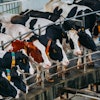
National Grain & Feed Association's David Fairfield, senior vice president of feed, shared his thoughts on the critical issues the U.S. feed sector must prepare for in 2025.
1. Elections to shape 2025 operating environment
Outcomes from the November elections will certainly influence the 2025 operating environment for the U.S. feed industry.
A new Trump administration would likely take on similar policy priorities as during its first term, with a strong focus on the economy, tax, energy, immigration and trade. Consistent with previous presidential transitions, Donald J. Trump would likely impose a regulatory freeze on any regulations under development to assess which rules should be halted versus which rules should be allowed to proceed.
While a Harris administration would likely continue many of the policy objectives seen under President Joe Biden, Kamala Harris is more progressive than Biden as demonstrated by her record in California and as a U.S. senator. A Harris administration will likely focus on climate, antitrust/competition and tax as policy priorities.
Trump and Harris are expected to make extensive use of executive orders, particularly if there is divided government. Likewise, if one party controls all three chambers of government, we can expect either Trump or Harris to make use of the reconciliation process to enact high-priority policy issues. If Republicans control all three chambers, they will likely use the reconciliation process to move a 2025 tax bill quickly, with key provisions of the Tax Cuts and Jobs Act of 2017 expiring December 31, 2025. The Democrats would likely use reconciliation to move another large piece of legislation like the 2022 Inflation Reduction Act (IRA). Health care could be another major focus.
2. Trade challenges persist
Regardless of election outcomes, trade challenges for U.S. agricultural products will likely persist. The U.S. has not entered any new free trade agreements since 2012, and Fairfield does not anticipate this changing with either a Harris or Trump administration.
Trump has indicated that he would impose a 10% tariff across the board on countries where the U.S. has a significant trade deficit. He would likely use the imposition of these tariffs to try to negotiate trade concessions from these countries.
Under a Harris administration, NGFA expects a continued focus on single country agreements or smaller regional agreements, with labor and environment provisions a high priority in any new trade agreements.
In its initial estimate for fiscal year 2025, the U.S. Department of Agriculture (USDA) projects a record agricultural trade deficit of US$42.5 billion, a US$12 billion increase over this fiscal year. This outlook underscores persistent challenges in the U.S. agricultural trade landscape, driven by the strong U.S. dollar, heightened competition from countries like Brazil in key markets, and China's ongoing efforts to reduce its reliance on U.S. imports.
To advance trade in this environment, NGFA is supporting increased funding within the farm bill for USDA export promotion programs – such as the Market Access Program and Foreign Market Development Program – to expand international export of U.S. agricultural products. NGFA also has urged the Biden administration to engage in trade negotiations with Southeast Asian countries, including considering reengaging in the Comprehensive and Progressive Trans-Pacific Partnership (CPTPP) trade accord.
3. Feed ingredient approval processes evolve
In August, the U.S. Food and Drug Administration (FDA) and the Association of American Feed Control Officials (AAFCO) announced the agreement that facilitated each organization’s involvement in the longstanding AAFCO feed ingredient definition process would not be renewed upon its expiration on October 1, 2024.
"We were disappointed in this decision and are concerned the end of the partnership could lead to increased uncertainty and higher costs for approving new and innovative ingredients that are needed for the success of animal agriculture," Fairfield said.
As part of the transition away from the agreement, FDA is seeking comments about its existing animal food additive petition and generally recognized as safe (GRAS) notification programs concerning what, if any, changes could be made to better serve feed industry stakeholder needs and advance animal and public health. In addition, AAFCO is exploring other ways to conduct safety and effectiveness reviews of new feed ingredients through its definition framework. NGFA anticipates FDA and AAFCO taking further actions in 2025 related to the ingredient definition/approval processes.
"We are committed to working with both FDA and AAFCO during this transition so that feed ingredient approvals continue to ensure the safety and effectiveness of ingredients and, at the same time, are predictable and cost effective for firms desiring to bring new products to market," Fairfield said.
NGFA also continues to strongly support the Innovative FEED Act, which is bipartisan legislation amending the Federal Food, Drug and Cosmetic Act to give innovative feed ingredients, such as feed additives, an efficient way to come to market, allowing U.S. animal agriculture to improve its productivity and global competitiveness.
The bill would establish a new regulatory path for non-nutritive animal food ingredients that act in the animal’s gut to provide production benefits, address human food safety concerns and affect the byproducts from digestion from the animal. NGFA is actively working to gain passage of the Innovative FEED Act within the Congress.
4. Focus on sustainability continues
Under a Trump administration, climate and sustainability policies would likely emphasize further deregulation of environmental standards and increased support for fossil fuels. Donald J. Trump would likely roll back existing environmental regulations, aiming to remove restrictions on oil, gas, and coal industries to boost domestic production and economic growth.
"Specific to agriculture, we expect there would be a significant shift at a U.S. Department Agriculture (USDA) under Trump away from 'climate-smart' spending," Fairfield said. "Remaining climate funding proposed as part of the Inflation Reduction Act (IRA) could be proposed to be rescinded, and no additional climate-smart activities would likely be proposed."
Under a Kamala Harris administration, Fairfield said he would expect to see an even larger focus on climate and sustainability. A major focus will be full implementation of all climate funding provided in the IRA, including financial incentives for electric cars, clean energy, and climate-smart agriculture. A key question for a potential Harris administration is whether they will continue President Joe Biden’s focus on voluntary and incentive-based approaches as it relates to agriculture and the forestry sectors or propose mandates.
Repealing tax credits under the IRA would require congressional action, which could prove difficult even if Republicans sweep the election. Section 45Z of the IRA is slated to go into effect on January 1, 2025, and provides producers of clean transportation fuels transferable tax credits. For fuel producers that satisfy the section’s prevailing wage and apprenticeship requirements, the maximum credit amount is US$1 per gallon for non-sustainable aviation fuel (SAF) and US$1.75 per gallon for SAF.
For fuel ethanol facilities, low-carbon corn could be used to qualify for the maximum US$1 per gallon tax credit, and the value of such corn is estimated to be about 5.4 cents per bushel per point of carbon index reduction. The potential for farmers to generate additional revenue by adopting climate smart practices and receiving a premium for low carbon corn marketed for clean transportation fuel production has attracted considerable attention. The IRA directs the Treasury Department to issue implementation guidance on the 45Z tax credit by January 1, 2025, but timing of the release is uncertain.
Regardless of the November election outcomes, private sector sustainability initiatives continue to advance and have impacts on U.S. agriculture and the feed industry. Major food retailers continue to set ambitious sustainability goals to demonstrate to customers that the products they sell are produced responsibly. These goals often address several areas, such as carbon, waste, biodiversity, packaging, plant and animal health and welfare, and product use and design.
In response to private sector programs, the feed industry needs to identify sustainability criteria relevant to their operations and value chain. Often, determining the environmental footprint of products and operations is a first step. In particular, this means quantifying carbon emissions. For feed manufacturers, a large percentage of the carbon footprint is typically attributable to the grains, oilseeds and ingredients used to produce final products, so understanding carbon emissions through the supply chain is necessary.
On the international front, the European Union (EU) seems committed to holding fast on the January 1, 2025, implementation date for its deforestation regulation. The regulation will have a direct logistical, operational and financial impact on U.S. grain and oilseed domestic suppliers and exporters. The continued lack of workable guidance for the regulation from the EU is particularly concerning and will soon begin to have ramifications as the 2024 soybean crop is harvested and associated soy-based products are produced. NGFA is urging the U.S. Trade Representative and the USDA to engage the EU and member states to address a variety of implementation issues.
















